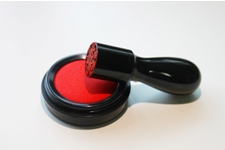Main Varieties of insho
- Published 2010.7.13
Main Varieties of insho
JitsuŌĆÖin (Õ«¤ÕŹ░)
 A jitsuŌĆÖin is basically an insho which has been registered at the city, district, town, or village hall. Other than individuals, corporations also use these registered jitsuŌĆÖin. Because they hold legitimate power, it is important to be careful not to lose them or let them be stolen. When purchasing real estate or vehicles, registering for marriage, inheriting property, or making other important contracts, it is required to attach the stamp registration certificate.
A jitsuŌĆÖin is basically an insho which has been registered at the city, district, town, or village hall. Other than individuals, corporations also use these registered jitsuŌĆÖin. Because they hold legitimate power, it is important to be careful not to lose them or let them be stolen. When purchasing real estate or vehicles, registering for marriage, inheriting property, or making other important contracts, it is required to attach the stamp registration certificate.
To avoid forgery, custom-made insho are solely used, as it is not possible to register a stamp that has been mass-produced. There are also restrictions on how large the seal impression can be.
Please see Registering Inkan for more information about the registration of jitsuin.
GinkoŌĆÖin (ķŖĆĶĪīÕŹ░)
The ginkoŌĆÖin is an insho used when opening an account at a bank or securities company.
MitomeŌĆÖin (Ķ¬ŹÕŹ░)
Used for common applications and transactions, mitomeŌĆÖin consist largely of mass-produced stamps with only the last name carved into them. They are also called sanmonban (ready-made seal).
Registering Inkan
People hoping to register an inkan, in other words, obtain a jitsuŌĆÖin, must go to the city hall at which they are registered as a resident. It is important to bring along the insho they wish to register, a passport or other personal identification, and enough money to pay for it. It is possible to have an insho registered by somebody other than themselves. Persons under the age of 15 cannot register an insho.
Insho that cannot be registered
- Insho which are shorter than 8 mm
- Insho which are longer than 25 mm
- Insho with seals which are made of easy-to-change rubber or plastic
- Insho without any contours, or insho with a noticeable deficit of contours
- Insho which do not have the person`s name, as according to their family register, carved into it. (AliasŌĆÖ and company names are not allowed)
After registration is completed, a card called the Inkan Registration Certificate is given out. Even without the actual jitsuŌĆÖin, it is possible to proceed with transactions as long as this card is present.
The Inkan Registration Certificate is an important document which basically says that the jitsuŌĆÖin used belongs to this person, and should be handled with utmost care.
Foreigners
It is possible for foreigners to also register an inkan.
Even if carved in kanji, katakana, or roman letters, as long as the insho has on it the personŌĆÖs full name or alias, it is possible to register it. However, in the case of using an alias, it is necessary to register that alias at the foreign registration office.
